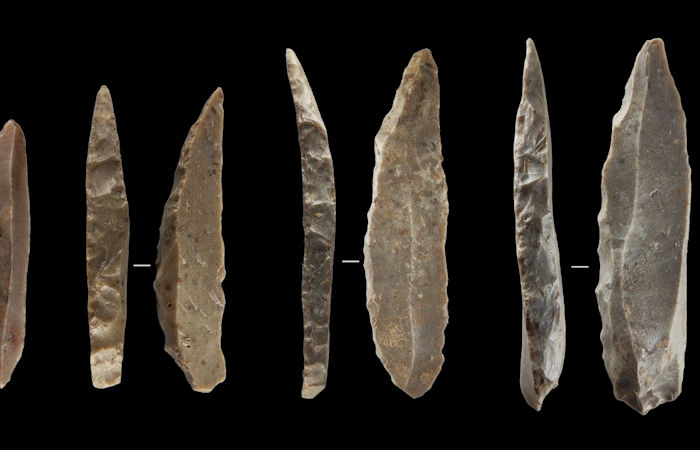Jan Bartek – AncientPages.com – The relationship between modern humans and neanderthals has been a subject of interest to anyone who wants to know more about our long-gone ancestors.
A new study sheds more light on our understanding of the existence of the two species of humans in Europe. Modern humans may have co-existed with Neanderthals in France and northern Spain for between 1,400 and 2,900 years before Neanderthals disappeared, according to a modeling study published in Scientific Reports.

Distinctive stone knives thought to have been produced by the last Neanderthals in France and northern Spain. This specific and standardized technology is unknown in the preceding Neanderthal record and may indicate a diffusion of technological behaviors between Homo sapiens and Neanderthals immediately prior to their disappearance from the region. Credit: Igor Djakovic
Recent fossil evidence suggests that modern humans (Homo Sapiens) and Neanderthals (Homo neanderthalensis) may have co-existed in Europe for as long as 5,000 to 6,000 years before Neanderthals became extinct. However, there is currently little evidence for their co-existence at a regional level and it is difficult to establish when the two species first appeared and disappeared in these areas.
Igor Djakovic and colleagues analyzed a dataset of 56 Neanderthal and modern human artifacts (28 for each group) from 17 archaeological sites across France and northern Spain, as well as an additional 10 Neanderthal specimens from the same region. All samples had been radiocarbon dated using robust modern techniques for greater accuracy.
The authors used Optimal Linear Estimation and Bayesian probability modeling to estimate the date ranges for these samples and the populations responsible, and infer the earliest and latest dates that these human groups might have been present at the sites. This modeling served to fill in missing portions of the archaeological record, which hamper date estimation.
Based on this modeling, the authors estimate that Neanderthals artifacts first appeared between 45,343 and 44,248 years ago, and disappeared between 39,894 and 39,798 years ago. The date of Neanderthal extinction, based on directly-dated Neanderthal remains, was between 40,870 and 40,457 years ago.
See also: More Archaeology News
Modern humans were estimated to first appear between 42,653 and 42,269 years ago. The authors conclude that this suggests the two species of humans co-existed in these regions for between 1,400 and 2,900 years. These results do not, however, indicate how or whether modern humans and Neanderthals interacted.
Written by Jan Bartek – AncientPages.com Staff Writer





